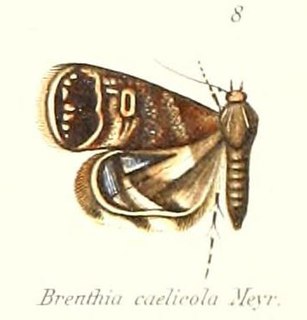Related Research Articles

Brenthia caelicola is a species of moth of the family Choreutidae. It was described by Edward Meyrick in 1910. It is found on the Kai Islands of Indonesia.
Brenthia salaconia is a species of moth of the family Choreutidae. It was described by Edward Meyrick in 1910. It is found on the Kai Islands of Indonesia.
Rhopalosetia is a monotypic moth genus in the family Copromorphidae. Its only species, Rhopalosetia phlyctaenopa, is found in French Guiana. Both the genus and species were first described by Edward Meyrick in 1926.
Hypatima dermatica is a moth in the family Gelechiidae. It was described by Edward Meyrick in 1921. It is found in Australia, where it has been recorded from Queensland.
Helcystogramma adaequata is a moth in the family Gelechiidae. It was described by Edward Meyrick in 1914. It is found in Guyana.
Ardozyga thyrsoptera is a species of moth in the family Gelechiidae. It was described by Edward Meyrick in 1904. It is found in Australia, where it has been recorded from Queensland.
Kiwaia glaucoterma is a species of moth in the family Gelechiidae. It was described by Edward Meyrick in 1911. It is endemic to New Zealand.
Ethirostoma semiacma is a moth in the family Gelechiidae. It was described by Edward Meyrick in 1914. It is found in Guyana.
Anacampsis multinotata is a moth of the family Gelechiidae. It was described by Edward Meyrick in 1918. It is found in Guyana.
Photodotis prochalina is a moth of the family Gelechiidae. It was described by Edward Meyrick in 1911. It is found in South Africa.
Antaeotricha pactota is a moth of the family Depressariidae. The species was first described by Edward Meyrick in 1915. It is found in Guyana and Pará, Brazil.
Thubana bullulata is a moth in the family Lecithoceridae. It was described by Edward Meyrick in 1923. It is found in India (Assam).
Comotechna dentifera is a moth in the family Depressariidae. It was described by Edward Meyrick in 1921. It is found in Brazil and Peru.
Comotechna scutulata is a moth in the family Depressariidae. It was described by Edward Meyrick in 1921. It is found in Brazil.
Antaeotricha orthriopa is a species of moth in the family Depressariidae. It was described by Edward Meyrick in 1925. It is found in Brazil.
Antaeotricha refractrix is a moth in the family Depressariidae. It was described by Edward Meyrick in 1930. It is found in Brazil.
Antaeotricha melanopis is a moth in the family Depressariidae. It was described by Edward Meyrick in 1909. It is found in Peru.
Moca aphrodora is a species of moth in the family Immidae first described by Edward Meyrick in 1922. It is found in Brazil and Peru.
Imma eriospila is a species of moth in the family Immidae. It was described by Edward Meyrick in 1922. It is found in Pará, Brazil.

Trachypepla galaxias is a moth of the family Oecophoridae first described by Edward Meyrick in 1883. It is endemic to New Zealand and can be found throughout the country. This species inhabits native forest. The life history of this species is currently unknown. Adults are on the wing from October to February, are nocturnal and are attracted to light.
References
- ↑ Savela, Markku, ed. (January 18, 2015). "Nosphistica erratica Meyrick, 1911". Lepidoptera and Some Other Life Forms. Retrieved September 7, 2020.
- ↑ Journal of the Bombay Natural History Society. 20 (3): 733.
 This article incorporates text from this source, which is in the public domain .
This article incorporates text from this source, which is in the public domain .